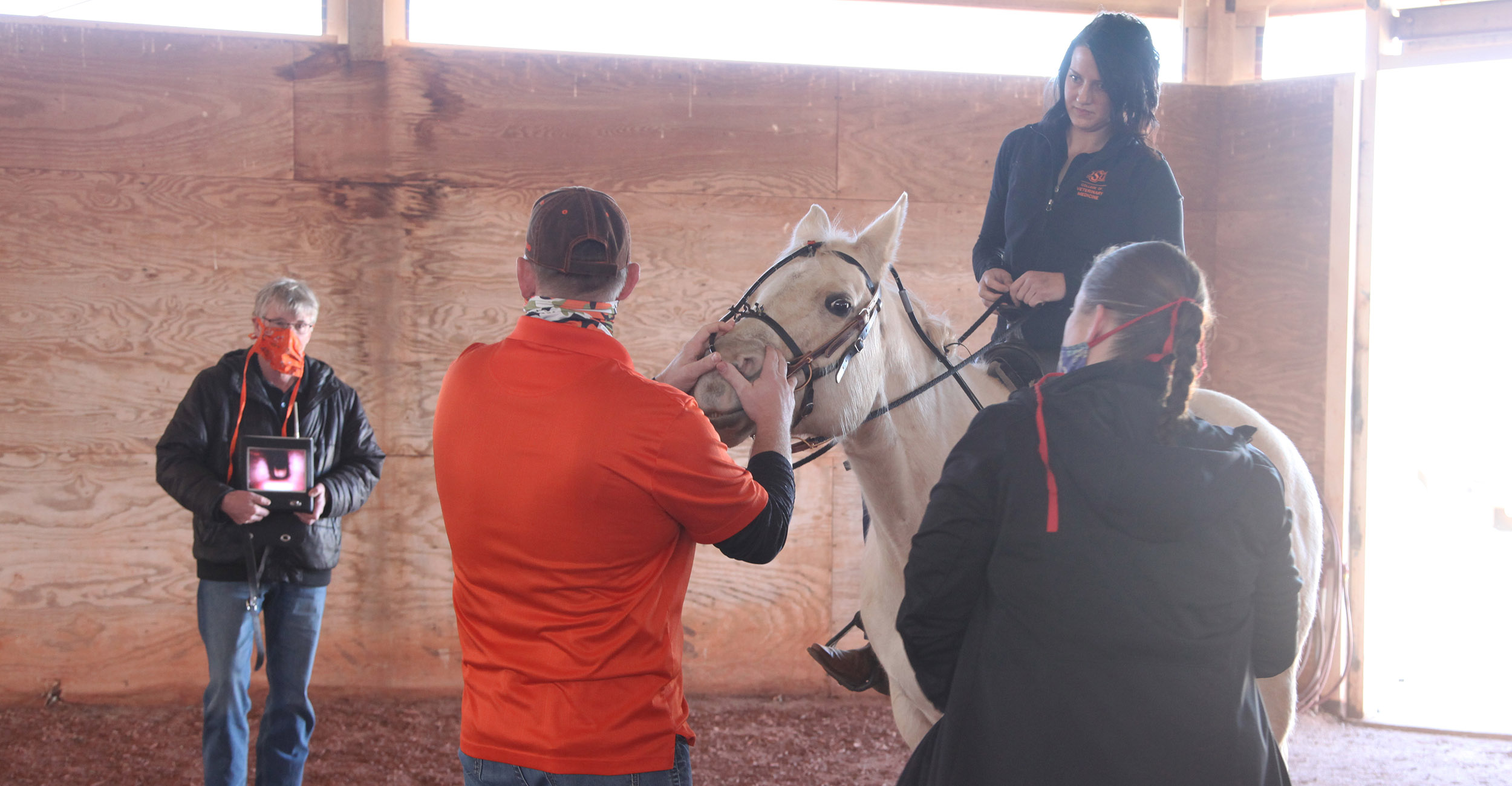
When horses roar: Evaluating the equine upper respiratory tract
Monday, April 19, 2021
Horses are exceptional athletes that perform in a wide variety of disciplines. Their muscles use a lot of energy, which is largely produced through a process called aerobic metabolism, using oxygen to convert carbohydrates and fats to ATP, the energy source used by muscle cells. An adequate supply of oxygen to the muscle cell is critical — if a horse can’t breathe well, it can’t perform well.
The air supply begins at the horse’s upper respiratory tract (URT), which includes the nostrils, nasal passages, pharynx and larynx. URT dysfunction is common in horses, manifesting as abnormal respiratory noise, poor or decreased performance, dysphagia (an inability to swallow correctly), and involuntary aerophagia (“wind-sucking”).
Airway dynamics play a significant role in equine URT disorders. Horses breathe exclusively through their nose. Such breathing creates substantial resistance to airflow, generating significant negative pressure within the URT during inspiration. During heavy exercise, airflow and inspiratory negative pressure increase approximately 20 times compared with that experienced at rest, often causing URT dysfunction.
Evaluating a horse’s URT involves a series of diagnostic steps. Gathering a thorough history, including a detailed discussion of the horse’s clinical signs, is incredibly helpful. A thorough physical examination is important to evaluate the horse for other causes of the clinical signs, such as a heart problem.
Resting endoscopy is often performed by inserting a special flexible tube containing a camera (an endoscope) through one or both nostrils to visually examine the anatomy and the resting function of the URT. This is usually performed in an awake, un-sedated horse, although some restraint may be necessary. Some disorders are readily diagnosed with resting endoscopy, but many disorders only occur (or occur more dramatically) during exercise.
Dynamic or exercise endoscopy is considered the “gold standard” way to diagnose functional URT disorders in horses. It uses a special endoscope and video capture system with a wireless communication device that is incorporated into either the saddle pad, strapped to a surcingle, or in a backpack worn by a rider. The endoscope itself is flexible but maintains its shape once passed and secured into the nasal passage of the horse. The URT can then be observed as the horse exercises.
Speed, gait, duration of exercise, directional changes, head position and rider interventions can have a significant effect on the identification of certain functional abnormalities of the URT. Many horses with a “normal” resting endoscopy will have an abnormality identified with a dynamic endoscopy, and some horses will even have multiple abnormalities observed.
The two most common disorders seen in performance horses are laryngeal hemiplegia and dorsal displacement of the soft palate. Laryngeal hemiplegia is commonly referred to as roaring due to its characteristic inspiratory noise. This disorder affects one or both of the arytenoids (the cartilages that cover the opening to the trachea during swallowing), also sometimes referred to as the flappers. Laryngeal hemiplegia results from dysfunction of the muscle that holds the arytenoid out of the airway during inspiration. This narrows the airway and decreases airflow and the oxygen supply to the lungs.
Dorsal displacement of the soft palate occurs when the division between the nasal
and oral portions of the pharynx becomes dislodged. This inhibits the horse’s ability
to exhale, usually resulting in an expiratory noise sometimes described as snoring.
Successful treatment for these disorders often requires surgery.
Laryngeal hemiplegia is typically treated by performing a prosthetic laryngoplasty, more commonly known as a Tie-back, and dorsal displacement of the soft palate is commonly treated with surgical advancement of the larynx, also known as a Tie-forward. With either diagnosis and subsequent treatment, the chance of an affected horse returning to its previous level of performance is good.
The Equine Surgery and Sports Medicine Service at the OSU Veterinary Medical Hospital offers full diagnostic capabilities, including dynamic endoscopy, to thoroughly evaluate your horse’s URT. If your horse suffers from poor performance or makes an unusual respiratory noise, OSU’s experts in equine surgery and sports medicine will evaluate your horse, diagnose the problem, and guide you through a treatment plan to get your horse back to performing at its best.
About the author: Kelsey Jurek, DVM, is a second-year equine surgery resident at the Oklahoma State University College of Veterinary Medicine. She is mentored by Dr. Mike Schoonover, an associate professor who is board certified in both equine surgery and equine sports medicine and rehabilitation.
Veterinary Viewpoints is provided by the faculty of the OSU Veterinary Medical Hospital. Certified by the American Animal Hospital Association, the hospital is open to the public providing routine and specialized care for all species and 24-hour emergency care, 365 days a year. Call 405-744-7000 for an appointment or more information.
OSU’s College of Veterinary Medicine is one of 30 accredited veterinary colleges in the United States and the only veterinary college in Oklahoma. The college’s Boren Veterinary Medical Hospital is open to the public and provides routine and specialized care for small and large animals. The hospital offers 24-hour emergency care and is certified by the American Animal Hospital Association. For more information, visit https://vetmed.okstate.edu or call 405-744-7000.
